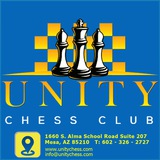White had evidently overlooked that after 19.Nxb5 fxg2! 20.Rxf8+ Rxf8, he cannot save the knight on b5: 21.Nc3? Bh3–+.
The black knight has transferred from c7 to d4, creating strong threats on the kingside.
A technical decision in Botvinnik’s style. Black goes into an endgame with an extra pawn.
A tactician would have decided the game in the following fashion: 23...Qh5!? 24.f4 Rf6 25.f5 Bxf5 26.exf5 Nxf5, with a winning attack.
A tactician would have decided the game in the following fashion: 23...Qh5!? 24.f4 Rf6 25.f5 Bxf5 26.exf5 Nxf5, with a winning attack.
Black has an extra pawn and great winning chances, although subsequently, he failed to cope with the technical problems, and the game ended in a draw.
Unity Chess Club
Sergei Karjakin 2660 Viswanathan Anand 2792 Wijk aan Zee 2006 Black to move
The position is improbably sharp and at first glance hard to assess. White’s king is exposed, but his greater space and advanced kingside pawns seriously cramp Black, and represent a potential threat. One way or another, the active black pieces are insufficient to carry out an attack, and he needs to bring up his reserves. This is impossible to do without sacrifices, so...
If this move were not available, Black would have to play 24...Nf6!? 25.gxf6 Bxf6 26.Bd4 Rc8, retaining strong compensation for the pawn.
This attempt at counterplay fails, but going over to defence also loses:
A) 27.Bc5 Rxa3 28.bxa3 Rxc5 29.a4 Na3+ 30.Kb2 Rc2+ 31.Kxa3 Qb8! 32.Ra1 b2;
B) 27.Bd4 Rxa3 28.bxa3 Nxa3+ 29.Kb2 Nc4+ 30.Kc3 (30.Kxb3 Qa3+ 31.Kc2 Ne3+ 32.Kd2 Rc2+ 33.Ke1 Qb4+) 30...Qa2 31.Bc5 Qc2+ 32.Kd4 dxc5+ 33.Kd5 Ne3+ 34.Kd6 Nxd1.
A) 27.Bc5 Rxa3 28.bxa3 Rxc5 29.a4 Na3+ 30.Kb2 Rc2+ 31.Kxa3 Qb8! 32.Ra1 b2;
B) 27.Bd4 Rxa3 28.bxa3 Nxa3+ 29.Kb2 Nc4+ 30.Kc3 (30.Kxb3 Qa3+ 31.Kc2 Ne3+ 32.Kd2 Rc2+ 33.Ke1 Qb4+) 30...Qa2 31.Bc5 Qc2+ 32.Kd4 dxc5+ 33.Kd5 Ne3+ 34.Kd6 Nxd1.
27...hxg6 28.fxg6 Nxa3+ 29.bxa3 Rxa3 30.gxf7+ Kh7 31.f8=N+ Rxf8 32.Qxf8 Ra1+ 33.Kb2 Ra2+ 34.Kc3 Qa5+ 35.Kd3 Qb5+ 36.Kd4 Ra4+ 37.Kc3 Qc4+
